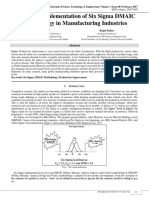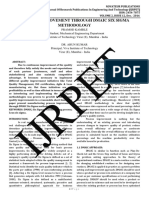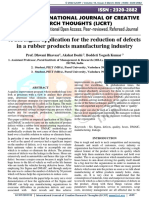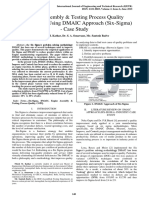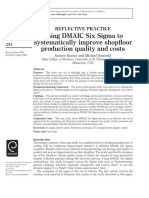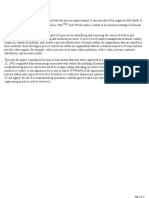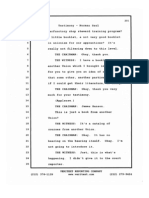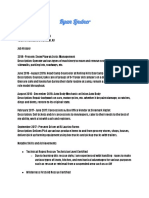Professional Documents
Culture Documents
Reduction of Defect and Variation Using Six Sigma Methodology Inan Instrument Manufacturing Company
Original Title
Copyright
Available Formats
Share this document
Did you find this document useful?
Is this content inappropriate?
Report this DocumentCopyright:
Available Formats
Reduction of Defect and Variation Using Six Sigma Methodology Inan Instrument Manufacturing Company
Copyright:
Available Formats
Volume 8, Issue 9, September – 2023 International Journal of Innovative Science and Research Technology
ISSN No:-2456-2165
Reduction of Defect and Variation using
Six Sigma Methodology in an Instrument
Manufacturing Company
Department of Mechanical, Industrial, Aerospace
Engineering Concordia University Montreal Canada
Dhananjay Mrutunjay Nayak
Harsha Nagadasanahalli Suresh
Devanshu Rathore
Darpan Kumar
Karishma Raghu Shetty
Concordia University
Abstract:- Our Project centres around the II. LITERATURE REVIEW
implementation of the Six Sigma DMAIC methodology,
a structured approach utilized by organizations to Six Sigma and its Methodology
effectively address challenges and achieve their Since its inception in the manufacturing sector, Six
objectives. The project's objective is to decrease the Sigma is a highly effective method of process improvement
rejection rate of valves and variation in the Instrument and quality management that has been adopted by several
Manufacturing Company process in Gujarat, India. industries. A process's flaws, variances, and errors must be
Following the systematic steps of Define, Measure, kept to a minimum to attain near-perfect levels of
Analysis, Improve, and Control (DMAIC) within the Six performance and customer satisfaction. The methodology
Sigma framework, the project study aims to identify the makes use of the DMAIC (Define, Measure, Analyze,
root cause(s) of defects and provide a reliable solution to Improve, Control) structured approach to identify the root
reduce or eliminate them thereby enhancing operational causes of problems, measure process performance, examine
capabilitiesmaking it a valuable tool for the organization. data for opportunities for improve ment, implement changes,
and establish control measures to maintain the
I. INTRODUCTION improvements.
Company Overview DMAIC
The instrument manufacturing industry is a diverse and DMAIC is a data-driven approach used for optimizing
dynamic industry that plays an important role in providing and improving existing business designs and processes. It is
precision instruments, equipment and instruments in various an effective method of controlled change management. The
fields including scientific research, medical, etc. healthcare, five phases of DMAIC are listed below, and each phase
engineering, electronics, aerospace, etc. This industry involves tools and tasks to help find the final solution.
designs, manufactures and distributes a wide range of tools
to support process measurement, analysis, control, and Define the problem and the goals of the project.
monitoring. Measure the different aspects of the existing process in
detail.
Valve manifolds are noted for their durability, Analyze data to find the main flaw in a process.
dependability, and precision, making them excellent for use Improve the given process.
in harsh settings. To satisfy the individual demands of the Control the way the process is implemented in the future.
customers, they provide a wide choice of conventional and
custom-designed valve manifold alternatives. Six Sigma's guiding principles include a relentless
focus on customer needs, making decisions based on data
In addition to high-quality valve manifolds, the and facts rather than preconceptions, and allowing cross-
company offers customer service and technical assistance. functional teams to collaborate in the quest for process
The team of professionals is available to assist you in improvement. Organizations can improve productivity, cut
selecting the best valve manifold for your application as well costs, improve product quality, and develop a culture of
as with installation and maintenance. continuous improvement by implementing Six Sigma,
making it a powerful tool for attaining operational
excellence and providing superior value to consumers.
IJISRT23SEP626 www.ijisrt.com 1058
Volume 8, Issue 9, September – 2023 International Journal of Innovative Science and Research Technology
ISSN No:-2456-2165
III. DEFINE PHASE characteristics of the valve that are most important to
customers and the business.
The purpose of this phase is to clearly state the
problem and to establish measurable goals for reducing Project Charter
defects and improving overall quality. A project charter is a concise, formal document
that outlines the project's goals, scope, schedule,
This information is usually documented to write down resources, and key stakeholders, providing a clear roadmap
what you currently know to determine the critical quality for successful project implementation labour.
Table 1 Project Charter
PROJECT CHARTER
Project Name: Reduction of Defect and Variation Using Six Sigma Methodology in an
Instrument Manufacturing Company
Problem Statement:
1. Reduce defects and rework during valve manifold production.
2. Decrease process variation, leading to a more consistent and reliable product.
Project Scope:
Critical parameters that are impacting the creation of defects and process variation shall beidentified and improved using the
DMAIC methodology.
Project Objective / Goal Statement:
Our main goal focuses on optimizing the manufacturing process of valve manifolds, aimingto streamline production, minimize
defects, and reduce variation in the final output. We will analyze the key stages of the manufacturing process, identify
bottlenecks, and implement data-driven solutions to enhance efficiency and quality.
Metrics Baseline Goal
Defects Per Million Opportunities (DPMO) DPMO = (181/2500) *1000000 =72400 Reduce DPMO by25%.
Process Sigma (σ)
Define Measure Tools used: - Check Analysis Improve Tools used: Control Tools used: -
Tools used: -Process Sheets Tools used: - -DOE SOP
MapCTQ Tree Data CollectionP Chart Pareto Analysis Fishbone
R&R Analysis DiagramANOVA
Team Members:
Dhananjay Mrutunjay Nayak, Harsha Nagadasanahalli Suresh, Devanshu Rathore, DarpanKumar, Karishma Raghu Shetty
Process Map
A process map is a visual representation of a workflow, illustrating the sequence of activities, decision points, and
interactions within a process, allowing for better understanding, analysis, and process improvement.
IJISRT23SEP626 www.ijisrt.com 1059
Volume 8, Issue 9, September – 2023 International Journal of Innovative Science and Research Technology
ISSN No:-2456-2165
High-Level Manufacturing Process Map
Fig 1 High-Level Manufacturing Process Map
CTQ Tree
The CTQ (Critical-to-Quality) tree is a powerful tool in the Six Sigma methodology that helps identify andprioritize the most
important quality characteristics (CTQs) of a product or process, tailoring them to the requirements customers to drive targeted
improvement efforts.
IJISRT23SEP626 www.ijisrt.com 1060
Volume 8, Issue 9, September – 2023 International Journal of Innovative Science and Research Technology
ISSN No:-2456-2165
Fig 2 CTQ Tree
IJISRT23SEP626 www.ijisrt.com 1061
Volume 8, Issue 9, September – 2023 International Journal of Innovative Science and Research Technology
ISSN No:-2456-2165
IV. MEASURE PHASE
The measure phase is about the baseline of the current process, data collection, validating the measurement system, and
determining the process capability
Check Sheet
Table 2 Check Sheet
Inspection Check Sheet
Data Collection
Data collection is the systematic process of collecting and recording relevant information and observations from a variety of
sources, providing the basis for analysis, decision-making, and information generation, research, business, and other fields.
We have collected data in the month of April 2023 where there were 10 lots each of 250 valves manufactured. From the
check sheets from the In Process Inspection and Final Dispatch Inspection, we collected the.
Table 3 Data on defects
Sr. No Lot No of Machining Dimension Body Alignment Marking Leakage
Size defects Error Error Finish test
1 250 11 8 2 1 0 0 0
2 250 23 16 4 1 1 1 0
3 250 15 9 3 3 0 0 0
4 250 18 12 4 1 1 0 0
5 250 7 2 1 2 1 0 1
6 250 23 15 4 2 0 2 0
7 250 28 21 5 1 0 0 1
8 250 19 11 5 3 0 0 0
9 250 16 7 3 3 0 3 0
10 250 21 14 5 2 0 0 0
Total 2500 181 115 36 19 3 6 2
KPI Identification Process Sigma
From the above we have identified the following two Our current process sigma level is shown below.
KPIs: -
P Chart
Defects Per Million Opportunities A p-chart is a statistical control chart used in quality
Our current Defects Per Million Opportunities, DPMO management to track the percentage or percentage of
= (181/2500) *1000000 = 72400 nonconforming items in a sample or process, allowing
organizations to identify variations and take corrective
action to maintain process stability and quality.
IJISRT23SEP626 www.ijisrt.com 1062
Volume 8, Issue 9, September – 2023 International Journal of Innovative Science and Research Technology
ISSN No:-2456-2165
Fig 3 P-Chart
R&R Analysis
R&R analysis, also known as instrument repeatability and reproducibility analysis, is a statistical method used to evaluate the
variability and reliability of a measurement system, allowing the organization to determine whether a measurement tool or process
can produce the consistent and accurate results required for quality, process assurance and improvement.
Table 4 Operator Readings of Five Valves - Valve Body Length Dimension
Part Reading-01 Reading-02 Mean Range
Operator-01
1 119.98 119.97 119.975 0.01
2 120.12 120.15 120.135 0.03
3 120.26 120.29 120.275 0.03
4 119.91 119.93 119.92 0.02
5 120.28 120.29 120.285 0.01
Operator-02
1 119.91 119.98 119.945 0.07
2 120.11 120.12 120.115 0.01
3 120.21 120.26 120.235 0.05
4 119.91 119.88 119.895 0.03
5 120.26 120.29 120.275 0.03
Operator-03
1 119.99 120.01 120 0.02
2 120.13 120.18 120.155 0.05
3 120.11 120.19 120.15 0.08
4 119.92 119.88 119.9 0.04
5 120.32 120.31 120.315 0.01
Average 120.105 0.033
LCL Mean UCL
Range 0.000 0.033 0.107
Average 120.044 120.105 120.166
Sigma (e) 0.028
IJISRT23SEP626 www.ijisrt.com 1063
Volume 8, Issue 9, September – 2023 International Journal of Innovative Science and Research Technology
ISSN No:-2456-2165
Constants
D3 0
D4 3.267
A2 1.88
D2* 1.15
Table 5 Operator-01 Operator-02 Operator-03
Part Reading-01 Reading-02 Reading-01 Reading-02 Reading-01 Reading-02 Mean Range
1 119.98 119.97 119.91 119.98 119.99 120.01 119.973 0.1
2 120.12 120.15 120.11 120.12 120.13 120.18 120.135 0.07
3 120.26 120.29 120.21 120.26 120.11 120.19 120.220 0.18
4 119.91 119.93 119.91 119.88 119.92 119.88 119.905 0.05
5 120.28 120.29 120.26 120.29 120.32 120.31 120.292 0.06
Average 120.105 0.092
LCL Mean UCL Constants
Range 0 0.092 0.184368 D3 0
Average 120.061 120.105 120.149 D4 2.004
A2 0.483
D2* 2.56
Sigma (m) 0.0359
Sigma(repr) 0.0220
Part-to-part variation
R(p) 0.387 D2* 2.67
Sigma(p) 0.145
Sigma(t) 0.149
%EV 19.04%
%AV 14.75%
%R&R 24.08%
Table 6 Go and No-go Thread Plug Readings
Part Standard A B C Date Time Reproducibility Accuracy
1 1 1 1 1 Morning 1 1
1 1 0 1 1 Evening 0 0
2 0 0 0 0 Morning 1 1
2 0 0 0 0 Evening 1 1
3 1 1 1 1 Morning 1 1
3 1 1 1 0 Evening 0 0
1 1 1 1 1 Morning 1 1
1 1 1 1 1 Evening 1 1
2 0 0 0 0 Morning 1 1
2 0 1 1 1 Evening 1 0
3 1 1 1 1 Morning 1 1
3 1 1 1 1 Evening 1 1
83.33% 75%
Overall Week-01 Week-02
A B C A B C A B C
A 66.66 74.995 74.995 66.66 83.33 66.66 66.66 66.66 66.66
B 83.33 83.33 100 83.33 66.66 66.66
C 83.33 66.66 66.66
IJISRT23SEP626 www.ijisrt.com 1064
Volume 8, Issue 9, September – 2023 International Journal of Innovative Science and Research Technology
ISSN No:-2456-2165
Inspector A B C
Accuracy 83.33 83.33 75
Repeatability - 66.66+83.33+83.33/3=77.75 measurements can be generated and validated. It is at this
Reproducibility-83.33 stage that issues are analyzed using statistical methods and
Accuracy-74.99Bias-19.44 further inquiry.
Remarks Pareto Analysis
With the above calculation of Part-to-Part Variation, Pareto analysis, based on the Pareto principle (80/20
Repeatability and Reproducibility analysis, we conclude that rule), is a problem-solving technique that helps identify and
the Company has a healthy measurement system. prioritize the most important factors that contribute to a
problem or outcomeorganizations focus their efforts on some
V. ANALYZE PHASE of the most important areas with significant impact.
In the Analyze phase, data is collected so that Error Analysis
hypotheses about the root causes of variations in the process
Table 7 Error Analysis
Machining Error Dimension Error Body Finish Alignment Marking Leakage test
115 36 19 3 6 2
Fig 4 Pareto Chart on Machining Error Fig 5 Pareto Chart on Machining Error
Further, we will analyse what are the different types of Fishbone Diagram
machining errors and which machining error is the most With fishbone analysis, we investigate the possible
significant. cause and effect of the errors.
Fig 6 Fishbone Diagram
IJISRT23SEP626 www.ijisrt.com 1065
Volume 8, Issue 9, September – 2023 International Journal of Innovative Science and Research Technology
ISSN No:-2456-2165
Analyze Phase Analysis Null Hypothesis (H0):
From the above Analysis, we identified that the
following factors are responsible for Threading Errors. H01: The feed rate does not have a significant effect on
the pitch diameter. H02: The speed does not have a
Speed of the Machines significant effect on the pitch diameter.
Feed Rate H03: There is no interaction effect between feed rate and
Tool Material speed on the pitch diameter.
Coolant Type
Coolant Pressure Alternative Hypotheses (Ha):
After further investigation, causal factors like tool Ha1: The feed rate has a significant effect on the pitch
material, coolant type and coolant pressure are either diameter. Ha2: The speed has a significant effect on the
customer-specified or fixed during product development. pitch diameter.
Ha3: There is an interaction effect between feed rate and
Thus, our focus will be on two main factors, the Speed speed on the pitch diameter. Following are the results of
of the Machines and Feed Rate as they areoperator controlled ANOVA from Minitab: -
and we can see variability in these factors during Production.
ANOVA
Using ANOVA, we see that there is a relationship
between the Feed Rate and Speed of the machines on the
defects.
For the ANOVA, the following is the Null Hypothesis
Hypotheses Formulation: Fig 7 Factor Information
Fig 8 Anova Analysis
In conclusion, based on the analysis results and interpretation, you can reject the null hypotheses for feed rate and speed,
suggesting that both factors have a significant effect on pitch diameter. Additionally, the interaction effect between feed rate and
speed is also significant. The model appears to be a good fit for the data, explaining a substantial portion of the variability in pitch
diameter
IJISRT23SEP626 www.ijisrt.com 1066
Volume 8, Issue 9, September – 2023 International Journal of Innovative Science and Research Technology
ISSN No:-2456-2165
VI. IMPROVE PHASE
Design of Experiments
DOE is a statistical technique used in quality control for designing, controlling, evaluating, and interpreting groups of
experiments to make sound decisions at a low cost and in a short amountof time.
DOE is concerned with understanding the impacts of certain variables on other variables. The goal is to create a cause-and-
effect link between a variety of independent factors and relevant dependent variables. In the DOE competition, the dependent
variable is known as the response, while the independent variables are known as factors. Experiments are carried out at various
factor values known as levels. Each experiment run involves a different level of the researched factors.
Table 8 Doe Parameters M16 X 1.5
Experiment X1 (RPM) X2 (Feed Rate) Observation (Y)
1 1000 0.5 15.061
2 1000 0.5 15.059
3 1000 0.5 15.069
4 1000 0.5 15.058
5 1000 0.8 15.205
6 1000 0.8 15.189
7 1000 0.8 15.2
8 1000 0.8 15.07
9 1000 1 15.01
10 1000 1 15.034
11 1000 1 15.11
12 1000 1 15.143
13 1000 1.2 15.15
14 1000 1.2 15.123
15 1000 1.2 15.045
16 1000 1.2 15.118
17 1100 0.5 15.11
18 1100 0.5 15.132
19 1100 0.5 15.128
20 1100 0.5 15.121
21 1100 0.8 15.085
22 1100 0.8 15.092
23 1100 0.8 15.098
24 1100 0.8 15.079
25 1100 1 15.156
26 1100 1 15.168
27 1100 1 15.148
28 1100 1 15.152
29 1100 1.2 15.103
30 1100 1.2 15.118
31 1100 1.2 15.109
32 1100 1.2 15.099
33 1200 0.5 15.063
34 1200 0.5 15.078
35 1200 0.5 15.1
36 1200 0.5 15.088
37 1200 0.8 15.182
38 1200 0.8 15.191
39 1200 0.8 15.209
40 1200 0.8 15.179
41 1200 1 15.036
42 1200 1 15.001
43 1200 1 15.044
44 1200 1 15.034
45 1200 1.2 15.126
46 1200 1.2 15.117
IJISRT23SEP626 www.ijisrt.com 1067
Volume 8, Issue 9, September – 2023 International Journal of Innovative Science and Research Technology
ISSN No:-2456-2165
47 1200 1.2 15.134
48 1200 1.2 15.129
49 1250 0.5 15.204
50 1250 0.5 15.228
51 1250 0.5 15.213
52 1250 0.5 15.195
53 1250 0.8 15.077
54 1250 0.8 15.065
55 1250 0.8 15.08
56 1250 0.8 15.063
57 1250 1 15.157
58 1250 1 15.139
59 1250 1 15.161
60 1250 1 15.169
61 1250 1.2 15.024
62 1250 1.2 15.048
63 1250 1.2 15.037
64 1250 1.2 15.03
The above table shows the variations in the RPM and Feed Rate with respect to the variation in Pitch Diameter. We carried
out four trials for each with four levels of variation in the attributes. Each trial gave us a different pitch dimension, all the obtained
data are to be evaluated so that we can conclude which among the variation is suitable to obtain good dimension stability in future
work also.
ANOVA ON DOE
Fig 9 ANOVA ON DOE
IJISRT23SEP626 www.ijisrt.com 1068
Volume 8, Issue 9, September – 2023 International Journal of Innovative Science and Research Technology
ISSN No:-2456-2165
Fig 10 Fisher Pairwise Comparison
IJISRT23SEP626 www.ijisrt.com 1069
Volume 8, Issue 9, September – 2023 International Journal of Innovative Science and Research Technology
ISSN No:-2456-2165
The Fisher Pairwise Comparisons analysis for the Variation Using Six Sigma Methodology" initiative,
interaction between RPM and Feed Rate reveals significant strong emphasis should be placed on introducing process
differences in pitch diameter among different combinations. controls and standardization measures. Crucial parameters
Specifically, the Pitch Diameter at 1250 RPM with a Feed identified in earlier DMAIC phases should be closely
Rate of 0.5 and Pitch Diameter at 1200 RPM with a Feed Rate monitored to ensure they remain within specified limits.
of 0.8 is significantly better than other combinations. These Standardized work instructions, visual aids, and
findings emphasize the intricate interplay between RPM and comprehensive process documentation should be put in
Feed Rate on the pitch diameter outcomes in the needle valve place to guide operators and uphold consistency.
manufacturing process. Utilization of Statistical Process Control (SPC): To
maintain the achieved reductions in defects and process
Control Phase variation, Statistical Process Control techniques should be
The Control Phase of the "Reduction of Defect and harnessed. Continuous monitoring of control charts should
Variation Using Six Sigma Methodology" endeavour focuses be conducted to swiftly detect any shifts or trends in
on sustaining the advancements made in minimizing defects process performance. This proactive approach facilitates
and process variation. Through the deployment of a range of prompt corrective actions, safeguarding stable production.
tools, the initiative ensures the optimization, efficiency, and Continual Training and Skill Enhancement: Ongoing
uniformity of the valve manifold manufacturing process. training initiatives should be executed to elevate the
Precise process controls are methodically introduced, guiding competencies and understanding of operators and
operators in adhering to standardized procedures and pivotal pertinent staff members. The periodic training should
parameters. Statistical Process Control methods provide real- ensure that the workforce is well-equipped to adhere to
time surveillance, enabling swift actions to counter potential established protocols, effectively manage unforeseen
deviations. Ongoing training initiatives continually enhance situations, and proficiently sustain the improved
the workforce's skills, ensuring precise execution of the manufacturing process.
enhanced process. Consistent monitoring and audits ascertain Regular Monitoring and Auditing: Consistent audits and
alignment with established standards. Key performance process evaluations should be performed to assess
indicators are vigilantly monitored and communicated, adherence to established process controls and standards.
providing valuable insights into the effectiveness of control This continuous monitoring mechanism shall aid in the
measures and overall project triumph. By leveraging these early detection of potential issues or deviations, enabling
Control Phase tools, the overarching objective of timely interventions and corrective measures.
streamlining production, reducing defects, and lessening Measurement of Performance and Reporting: Essential
process variation is accomplished, culminating in heightened performance indicators (KPIs) should be diligently
efficiency and product quality. tracked to gauge the effectiveness of process controls and
enhancements. Progress and accomplishments should be
Control Phase Report: communicated through periodic performance reports,
offering stakeholders valuable insights into project
Implementation of Process Controls and Standardization: success.
During the Control Phase of the "Reduction of Defect and
IJISRT23SEP626 www.ijisrt.com 1070
Volume 8, Issue 9, September – 2023 International Journal of Innovative Science and Research Technology
ISSN No:-2456-2165
VII. CONCLUSION
To measure the above-chosen improvement decision, we have initiated the data of possible defects with the same volume and
number of lots of valves manufactured. Using the P Chart, wemeasure the.
Fig 11 Possible Process Sigma Level
From the Identified two KPIs: - REFERENCES
Defects Per Million Opportunities [1]. Pressure Regulator Valves Manufacturer, Instrument
Our New Defects Per Million Opportunities = Ball Valve Supplier, Exporter, Gujarat, India. (n.d.).
(121/2500) *1000000 = 48400 Improvement on DPMO = Pressure Regulator Valves Manufacturer, Instrument
(Initial DPMO - Final DPMO) / Initial DPMO Ball Valve Supplier, Exporter, Gujarat, India.
http://www.smiplvapi.com/ In-Text Citation:
Improvement on DPMO = (72400 - 48400) / 72400 (Pressure Regulator Valves Manufacturer, Instrument
Improvement on DPMO = 33.15% Ball Valve Supplier, Exporter, Gujarat, India, n.d.)
[2]. The Six Sigma Handbook, 5th edition, McGraw Hill
Process Sigma Level [3]. Excellence through quality | ASQ. (n.d.).
Our new process sigma level is 3.161 https://asq.org/
[4]. James Roughton, Nathan Crutchfield."Effectively
Improvement on Process Sigma Level = (Updated Managing a JHA Process using Six Sigma", Elsevier
Process sigma level - Initial process sigma level) / Initial BV, 2016
process sigma level [5]. www.invensislearning.com
[6]. www.iss-foundation.org
Improvement on Process Sigma Level = (3.161 – [7]. ieomsociety.org
2.958) / 2.958 Improvement on Process Sigma Level = [8]. www.ssu.ac.in
6.86% [9]. Supratim Dutta, Sanjita Jaipuria. "Reducing
packaging material defects in beverage production
We have reached our aim of the six-sigma project to line using Six Sigma methodology", International
reduce the defects by atleast25%. Journal of Six Sigma and Competitive Advantage,
2020
[10]. ROUGHTON. "Six Sigma as a Management
System:A Tool for Effectively Managing a JHA
Process", Job Hazard Analysis, 2008
IJISRT23SEP626 www.ijisrt.com 1071
You might also like
- Nuevas Herramientas Industriales 2021Document7 pagesNuevas Herramientas Industriales 2021hellsingNo ratings yet
- Ijert Ijert: Process Improvement Using DMAIC Approach: Case Study in Downtime ReductionDocument5 pagesIjert Ijert: Process Improvement Using DMAIC Approach: Case Study in Downtime ReductionHelder BezerraNo ratings yet
- Review On Implementation of Six Sigma DMAIC Methodology in Manufacturing IndustriesDocument4 pagesReview On Implementation of Six Sigma DMAIC Methodology in Manufacturing IndustriesIJSTENo ratings yet
- Practical Application of Six Sigma Methodology To Reduce Defects in A Pakistani Manufacturing CompanyDocument11 pagesPractical Application of Six Sigma Methodology To Reduce Defects in A Pakistani Manufacturing CompanyUmair SarwarNo ratings yet
- Implementation of Six Sigma Using DMAIC Methodology in Small Scale Industries For Performance Improvement-With-Cover-Page-V2Document7 pagesImplementation of Six Sigma Using DMAIC Methodology in Small Scale Industries For Performance Improvement-With-Cover-Page-V2sara hishamNo ratings yet
- Reduce Repair Rate of Welding ProcessesDocument3 pagesReduce Repair Rate of Welding ProcessesAnouar AbdelmoulaNo ratings yet
- Process Improvement Through Dmaic Six Sigma MethodologyDocument6 pagesProcess Improvement Through Dmaic Six Sigma MethodologyJournalNX - a Multidisciplinary Peer Reviewed JournalNo ratings yet
- Ijcrt2203332 PDFDocument4 pagesIjcrt2203332 PDFVenkat RamanaNo ratings yet
- Reducing The Defects Rate by The Implementation of Six Sigma Technique at Led-Bulbs Manufacturing CompanyDocument15 pagesReducing The Defects Rate by The Implementation of Six Sigma Technique at Led-Bulbs Manufacturing CompanyharshadNo ratings yet
- DMAIC ToolDocument4 pagesDMAIC ToolLINH TRẦN NGÔ KHÁNHNo ratings yet
- Reduce Reject Painting Process Using Six Sigma Method With Dmaic Approach and Experiments On Brake Disc Products (1 RC Hub) (Case Study in Pt. Xyz)Document11 pagesReduce Reject Painting Process Using Six Sigma Method With Dmaic Approach and Experiments On Brake Disc Products (1 RC Hub) (Case Study in Pt. Xyz)International Journal of Innovative Science and Research TechnologyNo ratings yet
- Bhargava 2021 IOP Conf. Ser. Mater. Sci. Eng. 1017 012034Document15 pagesBhargava 2021 IOP Conf. Ser. Mater. Sci. Eng. 1017 012034Jorge Durán MartínezNo ratings yet
- UNIT IV TQMDocument49 pagesUNIT IV TQMmohanravi1986No ratings yet
- Materials Today: Proceedings: Prateek Guleria, Abhilash Pathania, Rakesh Kumar Shukla, Shubham SharmaDocument7 pagesMaterials Today: Proceedings: Prateek Guleria, Abhilash Pathania, Rakesh Kumar Shukla, Shubham Sharmadany firmansyahNo ratings yet
- Defects Reduction in A Pump Manufacturing Industry Using Six Sigma MethodologiesDocument7 pagesDefects Reduction in A Pump Manufacturing Industry Using Six Sigma MethodologiesInternational Journal of Innovative Science and Research TechnologyNo ratings yet
- Reduction of Welding Defects Using Six Sigma Techniques: Research PaperDocument9 pagesReduction of Welding Defects Using Six Sigma Techniques: Research PaperblitzkrigNo ratings yet
- Six Sigma Technique' A Journey Through Its ImplementationDocument4 pagesSix Sigma Technique' A Journey Through Its ImplementationEditor IJTSRDNo ratings yet
- Engine Assembly & Testing Process Quality Improvement Using DMAIC Approach (Six-Sigma) - Case StudyDocument7 pagesEngine Assembly & Testing Process Quality Improvement Using DMAIC Approach (Six-Sigma) - Case StudyhsrNo ratings yet
- The Dmadv ModelDocument6 pagesThe Dmadv ModelAseel JameelNo ratings yet
- WCE2015 pp847-852Document6 pagesWCE2015 pp847-852VicenteNo ratings yet
- Alok ChutiyaDocument19 pagesAlok Chutiyaanurag trivediNo ratings yet
- Application of Six-Sigma For Process Improvement in Manufacturing Industries: A Case StudyDocument16 pagesApplication of Six-Sigma For Process Improvement in Manufacturing Industries: A Case StudyTRÂM Nguyễn Thị BảoNo ratings yet
- Utilization of Six Sigma (DMAIC) Approach For Reducing Casting DefectsDocument11 pagesUtilization of Six Sigma (DMAIC) Approach For Reducing Casting DefectsUNITED CADDNo ratings yet
- Implementation of Six Sigma Using DMAIC Methodology in Small Scale Industries For Performance ImprovementDocument6 pagesImplementation of Six Sigma Using DMAIC Methodology in Small Scale Industries For Performance ImprovementIJMER100% (1)
- Using DMAIC Six Sigma To Systematically Improve Shopfloor Production Quality and CostsDocument20 pagesUsing DMAIC Six Sigma To Systematically Improve Shopfloor Production Quality and CostsArturo ValentinNo ratings yet
- 10 1108 - Ijqrm 12 2018 0344Document16 pages10 1108 - Ijqrm 12 2018 0344Manassés Pinto Silva JuniorNo ratings yet
- Analysis of Automobile Industry: Six Sigma Approach: IjarcceDocument5 pagesAnalysis of Automobile Industry: Six Sigma Approach: IjarcceAbhishek D MahaleNo ratings yet
- Six Sigma Quality: Chapter TwelveDocument25 pagesSix Sigma Quality: Chapter TwelveTopan ArdiansyahNo ratings yet
- Redesign and Manufacturing by Using DmadDocument6 pagesRedesign and Manufacturing by Using Dmadblackberry7130gNo ratings yet
- Application of Quality Tools For The Purpose of Process Improvement in The Pharmaceutical IndustryDocument8 pagesApplication of Quality Tools For The Purpose of Process Improvement in The Pharmaceutical IndustryVivekNo ratings yet
- Implementation of Lean Manufacturing in Electronics IndustryDocument6 pagesImplementation of Lean Manufacturing in Electronics IndustryFuandika Fadhila RahmanNo ratings yet
- DMAIC Is A Highly Effective, Data-Driven, Five-Step Approach For Improving Existing Products andDocument3 pagesDMAIC Is A Highly Effective, Data-Driven, Five-Step Approach For Improving Existing Products andChitrang BohraNo ratings yet
- ChartsDocument2 pagesChartsKimberly MarquezNo ratings yet
- Six Sigma Methodology: SeminarDocument23 pagesSix Sigma Methodology: Seminarvishal kumar sinha100% (1)
- Manuscript (REVIEW PAPER1) - NewDocument5 pagesManuscript (REVIEW PAPER1) - NewAnand PathakNo ratings yet
- Week 8 - Ch12 Six Sigma QualityDocument36 pagesWeek 8 - Ch12 Six Sigma QualityFlorenciano Johanes PongohNo ratings yet
- Barriers in Implementing Six Sigma in Small and Medium Manufacturing EnterprisesDocument5 pagesBarriers in Implementing Six Sigma in Small and Medium Manufacturing EnterprisesIJRASETPublicationsNo ratings yet
- Implementation of Six Sigma Tools To Improve Supply Chain Efficiency of An Electronic Goods Manufacturing IndustryDocument13 pagesImplementation of Six Sigma Tools To Improve Supply Chain Efficiency of An Electronic Goods Manufacturing Industryishika maluNo ratings yet
- Design For Six Sigma OverviewDocument66 pagesDesign For Six Sigma OverviewVishal KulkarniNo ratings yet
- Six Sigma Methodology in Telecom Sector For Quality ImprovementDocument6 pagesSix Sigma Methodology in Telecom Sector For Quality Improvementkushal pramanickNo ratings yet
- Dmaic Literature ReviewDocument7 pagesDmaic Literature Reviewafmzzgeqdsedez100% (1)
- Six Sigma Case StudyDocument6 pagesSix Sigma Case StudyIslamSharaf100% (1)
- 7 - Improving Service Level Performance by Implementing Lean Six Sigma in Smes of The Gaming Peripherals Industry in Peru A Case StudyDocument16 pages7 - Improving Service Level Performance by Implementing Lean Six Sigma in Smes of The Gaming Peripherals Industry in Peru A Case Studyleylagale27No ratings yet
- Maximising Operational Uptime: A Strategic Approach To Mitigate Unplanned Machine Downtime and Boost Productivity Using Machine Learning TechniquesDocument13 pagesMaximising Operational Uptime: A Strategic Approach To Mitigate Unplanned Machine Downtime and Boost Productivity Using Machine Learning TechniquesInternational Journal of Innovative Science and Research TechnologyNo ratings yet
- Mmscience - 2020 12 - Application of Six Sigma Tools in The Production of Welded Chassis FramesDocument6 pagesMmscience - 2020 12 - Application of Six Sigma Tools in The Production of Welded Chassis FramesMohamed ElghayoubiNo ratings yet
- Mba Six SigmaDocument19 pagesMba Six SigmaMandhara KsNo ratings yet
- Document PDFDocument5 pagesDocument PDFAndre CalmonNo ratings yet
- Increased Productivity Through Six Sigma: International Journal of Emerging Technology and Advanced EngineeringDocument6 pagesIncreased Productivity Through Six Sigma: International Journal of Emerging Technology and Advanced EngineeringIrshad AliNo ratings yet
- MT - MFT 202203 0010Document10 pagesMT - MFT 202203 0010samya.gharbaouiNo ratings yet
- A Hybrid Framework Based On SIPOC and Six Sigma DMAIC For Improving Process Dimensions in Supply Chain NetworkDocument26 pagesA Hybrid Framework Based On SIPOC and Six Sigma DMAIC For Improving Process Dimensions in Supply Chain NetworkBruno SaturnNo ratings yet
- Exemplo de DmaicDocument25 pagesExemplo de DmaicRenê Grottoli SiqueiraNo ratings yet
- JARIE - Volume 5 - Issue 1 - Pages 10-26Document17 pagesJARIE - Volume 5 - Issue 1 - Pages 10-26Tareq HabibiNo ratings yet
- Mohamad 2019 IOP Conf. Ser. Mater. Sci. Eng. 530 012041Document12 pagesMohamad 2019 IOP Conf. Ser. Mater. Sci. Eng. 530 012041burnett “titi” accamNo ratings yet
- Improving Customer Delivery Commitments The Six Sigma Way: Case Study of An Indian Small Scale IndustryDocument23 pagesImproving Customer Delivery Commitments The Six Sigma Way: Case Study of An Indian Small Scale IndustryharshadNo ratings yet
- Seminar Proposal For SHSJ ADC Dan Elemia Ver 1.0Document57 pagesSeminar Proposal For SHSJ ADC Dan Elemia Ver 1.0Charlton S.InaoNo ratings yet
- Lean-Six Sigma Case Study To Improve Productivity in A Manufacturing IndustryDocument9 pagesLean-Six Sigma Case Study To Improve Productivity in A Manufacturing IndustrySHASHANK KUMAR RAI 22224011No ratings yet
- Six Sigma Process Improvements in Automotive Parts ProductionDocument8 pagesSix Sigma Process Improvements in Automotive Parts ProductionandullaNo ratings yet
- Six Sigma Information PDFDocument17 pagesSix Sigma Information PDFFidel AragonNo ratings yet
- Application of Game Theory in Solving Urban Water Challenges in Ibadan-North Local Government Area, Oyo State, NigeriaDocument9 pagesApplication of Game Theory in Solving Urban Water Challenges in Ibadan-North Local Government Area, Oyo State, NigeriaInternational Journal of Innovative Science and Research TechnologyNo ratings yet
- Exploring the Post-Annealing Influence on Stannous Oxide Thin Films via Chemical Bath Deposition Technique: Unveiling Structural, Optical, and Electrical DynamicsDocument7 pagesExploring the Post-Annealing Influence on Stannous Oxide Thin Films via Chemical Bath Deposition Technique: Unveiling Structural, Optical, and Electrical DynamicsInternational Journal of Innovative Science and Research TechnologyNo ratings yet
- Osho Dynamic Meditation; Improved Stress Reduction in Farmer Determine by using Serum Cortisol and EEG (A Qualitative Study Review)Document8 pagesOsho Dynamic Meditation; Improved Stress Reduction in Farmer Determine by using Serum Cortisol and EEG (A Qualitative Study Review)International Journal of Innovative Science and Research TechnologyNo ratings yet
- Detection of Phishing WebsitesDocument6 pagesDetection of Phishing WebsitesInternational Journal of Innovative Science and Research TechnologyNo ratings yet
- A Study to Assess the Knowledge Regarding Teratogens Among the Husbands of Antenatal Mother Visiting Obstetrics and Gynecology OPD of Sharda Hospital, Greater Noida, UpDocument5 pagesA Study to Assess the Knowledge Regarding Teratogens Among the Husbands of Antenatal Mother Visiting Obstetrics and Gynecology OPD of Sharda Hospital, Greater Noida, UpInternational Journal of Innovative Science and Research TechnologyNo ratings yet
- The Impact of Music on Orchid plants Growth in Polyhouse EnvironmentsDocument5 pagesThe Impact of Music on Orchid plants Growth in Polyhouse EnvironmentsInternational Journal of Innovative Science and Research Technology100% (1)
- Sustainable Energy Consumption Analysis through Data Driven InsightsDocument16 pagesSustainable Energy Consumption Analysis through Data Driven InsightsInternational Journal of Innovative Science and Research TechnologyNo ratings yet
- Esophageal Melanoma - A Rare NeoplasmDocument3 pagesEsophageal Melanoma - A Rare NeoplasmInternational Journal of Innovative Science and Research TechnologyNo ratings yet
- Vertical Farming System Based on IoTDocument6 pagesVertical Farming System Based on IoTInternational Journal of Innovative Science and Research TechnologyNo ratings yet
- Mandibular Mass Revealing Vesicular Thyroid Carcinoma A Case ReportDocument5 pagesMandibular Mass Revealing Vesicular Thyroid Carcinoma A Case ReportInternational Journal of Innovative Science and Research TechnologyNo ratings yet
- Influence of Principals’ Promotion of Professional Development of Teachers on Learners’ Academic Performance in Kenya Certificate of Secondary Education in Kisii County, KenyaDocument13 pagesInfluence of Principals’ Promotion of Professional Development of Teachers on Learners’ Academic Performance in Kenya Certificate of Secondary Education in Kisii County, KenyaInternational Journal of Innovative Science and Research Technology100% (1)
- Consistent Robust Analytical Approach for Outlier Detection in Multivariate Data using Isolation Forest and Local Outlier FactorDocument5 pagesConsistent Robust Analytical Approach for Outlier Detection in Multivariate Data using Isolation Forest and Local Outlier FactorInternational Journal of Innovative Science and Research TechnologyNo ratings yet
- Realigning Curriculum to Simplify the Challenges of Multi-Graded Teaching in Government Schools of KarnatakaDocument5 pagesRealigning Curriculum to Simplify the Challenges of Multi-Graded Teaching in Government Schools of KarnatakaInternational Journal of Innovative Science and Research TechnologyNo ratings yet
- Review on Childhood Obesity: Discussing Effects of Gestational Age at Birth and Spotting Association of Postterm Birth with Childhood ObesityDocument10 pagesReview on Childhood Obesity: Discussing Effects of Gestational Age at Birth and Spotting Association of Postterm Birth with Childhood ObesityInternational Journal of Innovative Science and Research TechnologyNo ratings yet
- Entrepreneurial Creative Thinking and Venture Performance: Reviewing the Influence of Psychomotor Education on the Profitability of Small and Medium Scale Firms in Port Harcourt MetropolisDocument10 pagesEntrepreneurial Creative Thinking and Venture Performance: Reviewing the Influence of Psychomotor Education on the Profitability of Small and Medium Scale Firms in Port Harcourt MetropolisInternational Journal of Innovative Science and Research TechnologyNo ratings yet
- Designing Cost-Effective SMS based Irrigation System using GSM ModuleDocument8 pagesDesigning Cost-Effective SMS based Irrigation System using GSM ModuleInternational Journal of Innovative Science and Research TechnologyNo ratings yet
- Detection and Counting of Fake Currency & Genuine Currency Using Image ProcessingDocument6 pagesDetection and Counting of Fake Currency & Genuine Currency Using Image ProcessingInternational Journal of Innovative Science and Research Technology100% (9)
- Ambulance Booking SystemDocument7 pagesAmbulance Booking SystemInternational Journal of Innovative Science and Research TechnologyNo ratings yet
- Utilization of Waste Heat Emitted by the KilnDocument2 pagesUtilization of Waste Heat Emitted by the KilnInternational Journal of Innovative Science and Research TechnologyNo ratings yet
- Impact of Stress and Emotional Reactions due to the Covid-19 Pandemic in IndiaDocument6 pagesImpact of Stress and Emotional Reactions due to the Covid-19 Pandemic in IndiaInternational Journal of Innovative Science and Research TechnologyNo ratings yet
- An Overview of Lung CancerDocument6 pagesAn Overview of Lung CancerInternational Journal of Innovative Science and Research TechnologyNo ratings yet
- Digital Finance-Fintech and it’s Impact on Financial Inclusion in IndiaDocument10 pagesDigital Finance-Fintech and it’s Impact on Financial Inclusion in IndiaInternational Journal of Innovative Science and Research TechnologyNo ratings yet
- Auto Tix: Automated Bus Ticket SolutionDocument5 pagesAuto Tix: Automated Bus Ticket SolutionInternational Journal of Innovative Science and Research TechnologyNo ratings yet
- An Efficient Cloud-Powered Bidding MarketplaceDocument5 pagesAn Efficient Cloud-Powered Bidding MarketplaceInternational Journal of Innovative Science and Research TechnologyNo ratings yet
- Effect of Solid Waste Management on Socio-Economic Development of Urban Area: A Case of Kicukiro DistrictDocument13 pagesEffect of Solid Waste Management on Socio-Economic Development of Urban Area: A Case of Kicukiro DistrictInternational Journal of Innovative Science and Research TechnologyNo ratings yet
- Forensic Advantages and Disadvantages of Raman Spectroscopy Methods in Various Banknotes Analysis and The Observed Discordant ResultsDocument12 pagesForensic Advantages and Disadvantages of Raman Spectroscopy Methods in Various Banknotes Analysis and The Observed Discordant ResultsInternational Journal of Innovative Science and Research TechnologyNo ratings yet
- Comparative Evaluation of Action of RISA and Sodium Hypochlorite on the Surface Roughness of Heat Treated Single Files, Hyflex EDM and One Curve- An Atomic Force Microscopic StudyDocument5 pagesComparative Evaluation of Action of RISA and Sodium Hypochlorite on the Surface Roughness of Heat Treated Single Files, Hyflex EDM and One Curve- An Atomic Force Microscopic StudyInternational Journal of Innovative Science and Research TechnologyNo ratings yet
- Examining the Benefits and Drawbacks of the Sand Dam Construction in Cadadley RiverbedDocument8 pagesExamining the Benefits and Drawbacks of the Sand Dam Construction in Cadadley RiverbedInternational Journal of Innovative Science and Research TechnologyNo ratings yet
- Predictive Analytics for Motorcycle Theft Detection and RecoveryDocument5 pagesPredictive Analytics for Motorcycle Theft Detection and RecoveryInternational Journal of Innovative Science and Research TechnologyNo ratings yet
- Computer Vision Gestures Recognition System Using Centralized Cloud ServerDocument9 pagesComputer Vision Gestures Recognition System Using Centralized Cloud ServerInternational Journal of Innovative Science and Research TechnologyNo ratings yet
- GST ProjectDocument24 pagesGST ProjectPratyush DeroliaNo ratings yet
- NR7625459356207507 ETicketDocument4 pagesNR7625459356207507 ETicketTanushree BiswasNo ratings yet
- EC Safety Data Sheet: 1. Name of Product, Characterization and Company NameDocument3 pagesEC Safety Data Sheet: 1. Name of Product, Characterization and Company NamemitramgopalNo ratings yet
- UBC Hearing PG 201-412Document212 pagesUBC Hearing PG 201-412Latisha WalkerNo ratings yet
- Office of The Controller of Examinations - Hall Ticket - Download-1Document2 pagesOffice of The Controller of Examinations - Hall Ticket - Download-1Shalini ShaliniNo ratings yet
- Pcp-1-Empo-Data-Base-Of-Arrested-Items-Confiscated-Feb. 18-24, 2019Document40 pagesPcp-1-Empo-Data-Base-Of-Arrested-Items-Confiscated-Feb. 18-24, 2019Mary Grace TrinidadNo ratings yet
- Gas Cutting & WeldingDocument71 pagesGas Cutting & WeldingSUDIPTA BHATTACHARJEE100% (1)
- A Gap in The WallDocument170 pagesA Gap in The WallSAUSANo ratings yet
- Sociotechnical Systems and Sustainability: Current and Future Perspectives For Inclusive DevelopmentDocument7 pagesSociotechnical Systems and Sustainability: Current and Future Perspectives For Inclusive DevelopmentKodem JohnsonNo ratings yet
- Product Information: Belclene 660 - Phosphonate Calcium Carbonate InhibitorDocument2 pagesProduct Information: Belclene 660 - Phosphonate Calcium Carbonate InhibitorEti SureniNo ratings yet
- A National Survey of American Economic Literacy PDFDocument6 pagesA National Survey of American Economic Literacy PDFIsmon IntanNo ratings yet
- Best Day Trading Indicators 2021 SARAH 1 4Document16 pagesBest Day Trading Indicators 2021 SARAH 1 4Garry Baker0% (1)
- Qualys VMDR® - All-in-One Vulnerability Management, Detection, and ResponseDocument3 pagesQualys VMDR® - All-in-One Vulnerability Management, Detection, and ResponseCasey Ips AspirantNo ratings yet
- HYDAC Understanding Proportional Hydraulics JAN 2015Document3 pagesHYDAC Understanding Proportional Hydraulics JAN 2015marc271986No ratings yet
- Ryan Lindner - ResumeDocument2 pagesRyan Lindner - Resumeapi-533954600No ratings yet
- FoldRite Furniture Co.Document4 pagesFoldRite Furniture Co.Hualu Zhao0% (1)
- Lakshya User ManualDocument27 pagesLakshya User ManualPrajakta WahurwaghNo ratings yet
- 68 Cequena Vs BolanteDocument7 pages68 Cequena Vs BolanteKrister VallenteNo ratings yet
- Advertising QuestionnaireDocument12 pagesAdvertising QuestionnaireJohn navarroNo ratings yet
- Parliament Sessions: Arpita Sharma ClassesDocument5 pagesParliament Sessions: Arpita Sharma ClassesHarish KumarNo ratings yet
- POMS Project ReportDocument65 pagesPOMS Project ReportPurushottam ChoudharyNo ratings yet
- Computers and Electrical Engineering: Fadi Al-Turjman, Chadi Altrjman, Sadia Din, Anand PaulDocument10 pagesComputers and Electrical Engineering: Fadi Al-Turjman, Chadi Altrjman, Sadia Din, Anand PaulAlfian ArdyansyahNo ratings yet
- Managerial AccountingMid Term ExaminationDocument3 pagesManagerial AccountingMid Term ExaminationjaeNo ratings yet
- Aerodynamic Stability Technology For Maneuverable MissilesDocument391 pagesAerodynamic Stability Technology For Maneuverable MissilesdalfeNo ratings yet
- Vintage Airplane - Sep 1987Document32 pagesVintage Airplane - Sep 1987Aviation/Space History LibraryNo ratings yet
- Otp BypassDocument2 pagesOtp Bypassjajaj monese0% (1)
- 01 January 1990 PDFDocument92 pages01 January 1990 PDFBruno MelandriNo ratings yet
- Forming Shoulder DesignDocument8 pagesForming Shoulder DesignAnonymous DjA2T2I2100% (1)
- Asprey Time Inc. - SMDocument48 pagesAsprey Time Inc. - SMJaja BelardoNo ratings yet
- Middlesex University Coursework 1: 2020/21 CST2330 Data Analysis For Enterprise ModellingDocument8 pagesMiddlesex University Coursework 1: 2020/21 CST2330 Data Analysis For Enterprise ModellingZulqarnain KhanNo ratings yet


